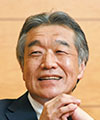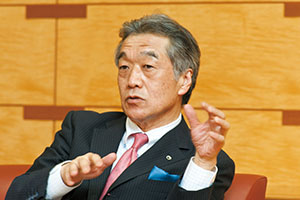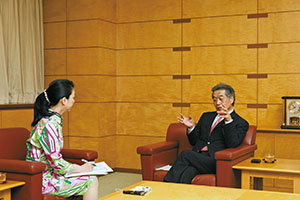 |
|
|
|
|
|
View from the Top Vol. 12, No. 9, pp. 1–4, Sept. 2014. https://doi.org/10.53829/ntr201409tp1  Seeing the Forest before Looking at the Trees—Merging Customer Needs with the Power of NTT EASTOverviewThe telecommunications industry is going through rapid and dramatic changes, and NTT EAST is unveiling a series of innovative policies to cope with this challenging business environment. In this transition to a new mindset, we asked Masahide Oka, Senior Executive Vice President of NTT EAST, to explain to us the logic that the company should use in providing services and the stance that it should take in facing today’s challenges. Keywords: management policy, B2B2C, collaboration A transition to a new mindset—providing services with a view to the customer’s future—Mr. Oka, can you first update us on the state of business at NTT EAST? At present, NTT EAST is strategically promoting the penetration of optical broadband. The number of subscribers to the FLET’S HIKARI high-speed optical-fiber connection service had been increasing steadily until three or four years ago, but the emergence of the smartphone and other new devices has forced optical broadband to compete with mobile communications, resulting in slower growth. To be more specific, the widespread penetration of smartphones and tablets is giving birth to a new “carry ICT with you” lifestyle that is bringing dramatic changes to the market environment. This reflects a change in direction, especially among the young, who want to make ICT a part of their daily life in a more enjoyable and stylish manner. Under these conditions, NTT EAST has no choice but to change its tactics, and for these last two years or so it has been reviewing and revising sales strategies. As before, they will be active in bringing Internet access to those who are still without it, and they will continue to propose value-added services. At the same time, however, they will turn their attention to new ways of using ICT. That is to say, our efforts to date have been mainly focused on the consumer market in the form of “connecting homes directly to optical broadband.” Now, however, considering the intrinsic utility and role of broadband, we must focus once more on providing broadband to corporate enterprises and organizations. In fact, we have redirected our sales strategies to expanding the broadband network not only to large companies but also to small- and medium-sized companies, SOHO (small office/home office) enterprises, and local governments, too.
—Questioning the company’s past approach to business seems to indicate a major transition. That’s right—it’s not simply a matter of changing our sales target from consumers to companies and thinking that that in itself will reap benefits. For example, our sales department has traditionally asked major electronics and other retailers to appeal to consumers to apply for our FLET’S broadband services, but they simply can’t approach the corporate world in the same way. Uncovering the particular problems that companies face, developing an accurate understanding of their management environment, and providing appropriate services all constitute work. Needless to say, our customers operate in various types of business environments, which means that the number and quality of ICT staff will also differ. It sometimes happens that a company does a good job in setting up network facilities but cannot make good use of them. There are also companies that hesitate to introduce a broadband network due to worries about having to seek support whenever a security issue or operating problem occurs. With this in mind, we have our sights set on creating a business environment in which our customers can use the network, including follow-up services, with peace of mind. In short, we aim to provide novel services ahead of their time. We are asking all NTT EAST employees to adopt this new mindset. This applies to all aspects of the company including sales practices, systems, technologies, and facilities. It is the sales staff who keep a direct eye on our customers. In the past, they placed a lot of weight on selling telecommunications equipment, but they are now active in hearing about the customer’s current business situation and looking to the future. Of course, upper management, to which input from the field eventually reaches, must be able to understand and analyze that input as thoroughly as possible, and in this area, I feel that drastic changes are necessary. At the same time, we are expanding our efforts in implementing robust disaster countermeasures based on lessons learned from the Great East Japan Earthquake. Last fall, we completed nearly all of the post-earthquake restoration work needed for the immediate future, but we continue to offer assistance to local governments in their restoration planning. What we must not forget here is the need to prepare for the next disaster. We must review countermeasures to disasters that are predicted to occur sometime in the future, such as an earthquake directly beneath the Tokyo metropolitan area. In the Great East Japan Earthquake, our telecommunication facilities were not adversely affected by the earthquake, but they sustained damage from the tsunami and the long-term and widespread power outage that followed. As a result of this experience, we have set up a system that will allow our customers to continue using services without worry even in the event of an earthquake occurring directly beneath the Tokyo metropolitan area. Responding flexibly to business needs (making a transition from B2C to B2B2C)—A new approach is being adopted at NTT EAST based on lessons learned. Isn’t the “Hikari Collaboration Model” one example of this new mindset? Our aim is to switch to a business-to-business-to-consumer (B2B2C) model in which end users make use of optical services through our customers’ companies. What we want to do here is devise novel services that combine the strengths of our customers’ companies with our optical services so that those companies can provide those services directly to end users as products under their own name and brand. We can expect this type of collaboration between our optical services and various types of businesses and market players to result in greater penetration of optical services and to improve the facility utilization rate. Of course, we will continue to apply the traditional B2C model, but going forward, we plan to shift our weight to this new B2B2C model.
—What specific measures are you taking in the network business area to respond flexibly to business needs? To begin with, we want to be able to respond to the diverse needs of our customers in the business world. In particular, we are working to enhance our network installation capabilities, as in providing bundled installation for multiple sites, time-designated installation, and late-night or early-morning installation. We are currently forming collaborative tie-ups with other companies and investigating the creation of an installation system that can deal as needed with such business needs. Furthermore, to deal with the ever-increasing volumes of traffic brought on by the expanded use of smartphones and tablets and faster transmission speeds, we plan to reduce the per-bit delivery cost by deploying a high-speed, large-capacity optical transmission infrastructure. We also plan to make operations more efficient by reducing on-site maintenance work through the introduction of remote-configuration functions. In these ways, we seek to provide services for business operators and respond flexibly to their diverse business needs. We also see a need for increasing network reliability. In recent years, cyber attacks have come to occur on a daily basis, and unauthorized accesses to the NTT EAST network have also been increasing. Fortunately, the network has not yet been adversely affected by hacking or other malicious activities, but given the need to boost network reliability in the face of diversifying attacks, we will work to fortify our measures against cyber attacks of all types. We plan to do this in various ways, such as by enhancing our defense and detection functions, upgrading our incident-response system, and developing highly qualified security personnel. In addition to the above, we are working to improve productivity with the aim of achieving cost-efficient operations. I believe that we have already achieved good results in work that is done off NTT premises by promoting composite work practices. For example, we have maintenance personnel perform systematic facility inspections between fault-repair assignments on customer premises. We are also working to improve productivity even further in work done on NTT premises through a “visualization” mechanism that we developed last fiscal year. Similarly, we have been engaged in a project to simplify the network since fiscal year 2013, and in this fiscal year, we have been implementing various processes such as those involving circuit switching in order to complete the project. Plus, we are carrying out the circuit switching or circuit removal processes according to the area of NTT base station units and distribution rack units for large buildings. In doing so, we are working to achieve an early power-consumption reduction effect and expand our “green” activities. Seeing the forest before looking at the trees. The knowledge of researchers holds great promise.—Mr. Oka, could you leave a message for all NTT EAST employees? One of my favorite mottos is “Tomorrow is a new day.” It is important that we have the ability to deal with future circumstances, i.e., to have a flexible stance to face whatever comes. Having experienced large and complex projects such as the G8 Hokkaido Toyako Summit as well as unprecedented disasters such as the Great East Japan Earthquake, I believe in the importance of positive thinking. As you know, many facilities collapsed, many lines were severed, and other types of damage occurred when that massive earthquake struck, but at such times, it doesn’t do us any good to just sit around and bewail the tragedy. Rather, it is important that we think about ways of making full use of what is there now, of what remains. Therefore, I have been very encouraged by the NTT EAST employees who have undertaken their work with a sense of mission based on this idea. I would like everyone to face the future with the same sense of mission. I would also like everyone to remember that it is equipment, the network, and systems that support services. We already have good results to show for our efforts: we brought the optical coverage rate to 99% as of the end of fiscal year 2013; we completed our work on expanding the NGN (Next Generation Network) and succeeded in maintaining stable operation; and we introduced efficiency-enhancement techniques to reduce costs. A few years ago, for example, we adopted a “total cost” point of view, which means that we manage costs based on the idea that depreciation costs, personnel expenses, and operational costs make up the total cost. That is, if a facility construction project should generate costs, but maintenance and operational expenses then decrease, the total cost should be the same. We have introduced this idea not only in facility work projects but also in the sales and indirect departments with very good results. This is an idea that relates to the future, in which we see the whole forest before looking at individual trees. Today, the way in which we interact with the world is changing dramatically. I would like everyone to continue with the serious efforts that they have been making so far, but I also want everyone to open a window to society. In sales, for example, we are setting up a system in which we, as an organization, can absorb and learn from the experiences that we have had through direct contact with our customers. I would like everyone to adopt such an attitude to the outside world and connect their experiences to the future.
—Finally, could you also say a few words to NTT researchers? I would also like our researchers to have such a sense of “seeing the forest before looking at the trees.” I expect researchers to offer their knowledge of how to apply current research activities to business. In this regard, I would like to see more discussions taking place between us and researchers than in the past. To all NTT researchers, I would say, “Please demonstrate your full ability at connecting the knowledge of the entire NTT laboratories to our business pursuits.” Interviewee profileCareer highlightsMasahide Oka entered Nippon Telegraph & Telephone Public Corporation (now NTT) in 1978. He served as Manager of NTT EAST Tochigi Branch from 2004, as Vice President, Executive Manager, Maintenance and Service Operation Department, Network Business Headquarters of NTT EAST from 2007, and as Senior Vice President, Executive Manager, Maintenance and Service Operation Department, Network Business Headquarters of NTT EAST from 2008. In June 2012, he took up his present position as Senior Executive Vice President of NTT EAST while concurrently serving as Senior Executive Manager, Network Business Headquarters and President of NTT-ME. |
|











